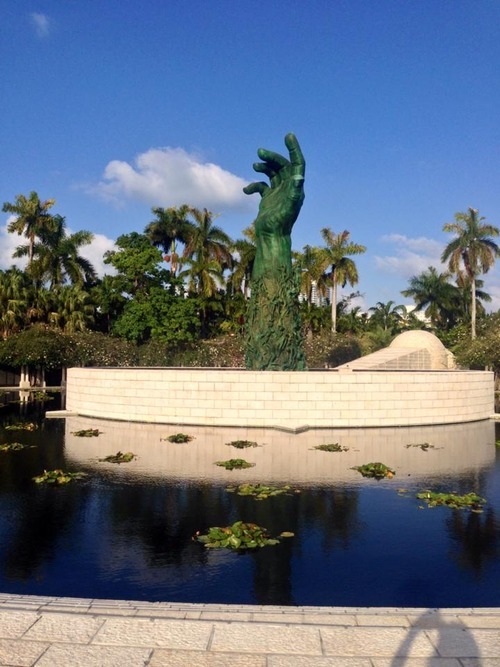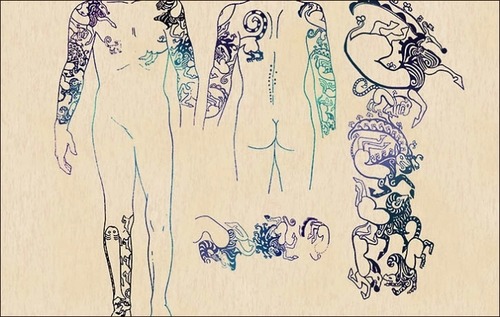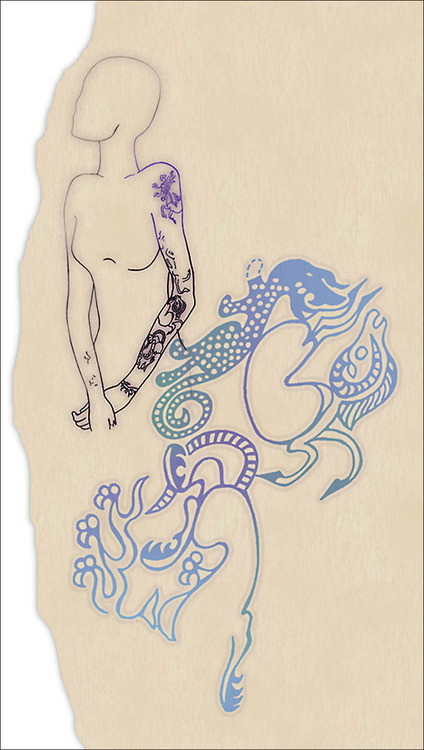In 2005, the U.N. General Assembly designated January 27th as the International Day of Commemoration in memory of victims of the Holocaust. It is well-known that each survivor has one number on their forearm. These numbers are all tattooed by the time of their arrival at the concentration camp.

(Taken at Miami Holocaust Memorial in 2014. If you zoomed in, you will see a number tattooed on the arm, half covered by the statues of people)
According to the United States Holocaust Memorial Museum, it states that originally the numbers were not marked on the forearm but across the chest with indelible ink. Yet, the serial number would be removed by the time they died (from whatever reason), as the clothes would be removed. This made them have no way to identify the bodies. Then they developed a metal stamp that holds interchangeable numbers (made up with needles of course), and punch on the upper chest of the prisoner at one blow, followed by rubbing in the ink. They then further modified the equipment with a single-needle device, and changed the tattooed site to the forearm instead. Since then, the tattooing was performed at the registration till the camp was dismissed.
Tattooing does not only for identification for living cases, like the one mentioned above in the Holocaust (though it is a tragic example to use). It is also very significant in forensic applications. The gigantic and disastrous tsunami in Thailand in 2004 killed thousands of people. Water and the heat worsen the decomposition of bodies; they were hardly to be recognized. Some of the bodies were identified, or provided clues for further identification leads by tattoos.
Tattoo patterns, and locations in fact tell a lot about the deceased (if it is in a forensic autopsy, or decomposed bodies), or the person. And, in the old days, social status. According to Byard (2013), Gang and prison tattoos are more often “crude” with antisocial message, an emphasis on death, and violence (what if someone is a bone lover like us, forensic anthropologists? Hmmm…). Whereas in western countries, choices of tattoos often only have decorative purposes, or personal meaning instead of a cultural meanings like those in gangs, or in tribal people. Western countries’ tattoos usually use customized tattoos to record relationships—“birth of children, or death of a friend or family member.” (Byard 2013) For the latter, they are called “commemorative tattoos,” it put cremated ashes from the person being memorialized mixed in with the pigment or the ink. Tattoos used to identify slaves and criminals like abovementioned case with Holocaust, can actually trace back to the Romans. Of course, some people would make good use of the ink, and tattooed their medical info or background on the arms, like blood type, certain genetic diseases.
Skins with tattooed pigment would decompose in a much slower rate than those without. Thus, it is possible to find a section of the tattooed skin in pretty good conditions even the body was found few years after, “even with quite pronounced putrefactive changes and loss of superficial skin layer,” according to Byard (2013).
Style and design of tattoos may give a pretty good background idea (age, or cultural background of the decedent). Sometimes, if it is a customized piece of art, it may allow the investigators to find the artist as well. The archaeological discovery of the Siberian princess, Princess Ukok in 1993 has well demonstrated the great preservation of tattoo.
Altai Aborigines says the mummy of princess Ukok is their progenitor. The tattoo on her arm in fact has hidden some important message for mankind. They believe that she passed away voluntarily to protect the Earth from evil spirits. The tattoo covers from her shoulder to her hand, and only left arm tattoo was preserved. Left should was the canvas for a mythical animal, an antlered deer with the beak of a vulture. “The antlers are adorned with vulture heads; a similar head can be seen on the back of the animal, the body of which is twisted, followed by a sheep with its head thrown back. The mouth of a spotted panther with a long tail is seen at the legs of the sheep.” The clash between vultures and hoofed animals symbolize the conflict between the two worlds: a predator from the lower world against the middle world (symbolizes by a herbivorous animal).


Though researchers found later that the Siberian mummy was in fact died from breast cancer and self-meditated with cannabis, which crumbled the voluntary death speech from the aborigines, it supports the studies Byard quoted, saying tattoos in ancient times signifies the special social status of that tattooed person. And for Princess Ukok, she might not be a real princess, but was believed as a shaman because of the visions she saw after using cannabis.
** Recently, the face of Princess Ukok has been reconstructed. Thanks to the well developed facial reconstruction techniques. Click here to have a look of how she looked like.**
Resources:
Byard, W. Roger. 2013. “Tattoos: forensic considerations.” Forensic Sci Med Pathol (2013) 9:534-542.
Pravda.ru. 2011. “Tattoos of Princess of Altai conceal mankind’s biggest mysteries”
Siberian Times. 2012. “Siberian Princess Reveals Her 2500 Years Old Tattoos.”